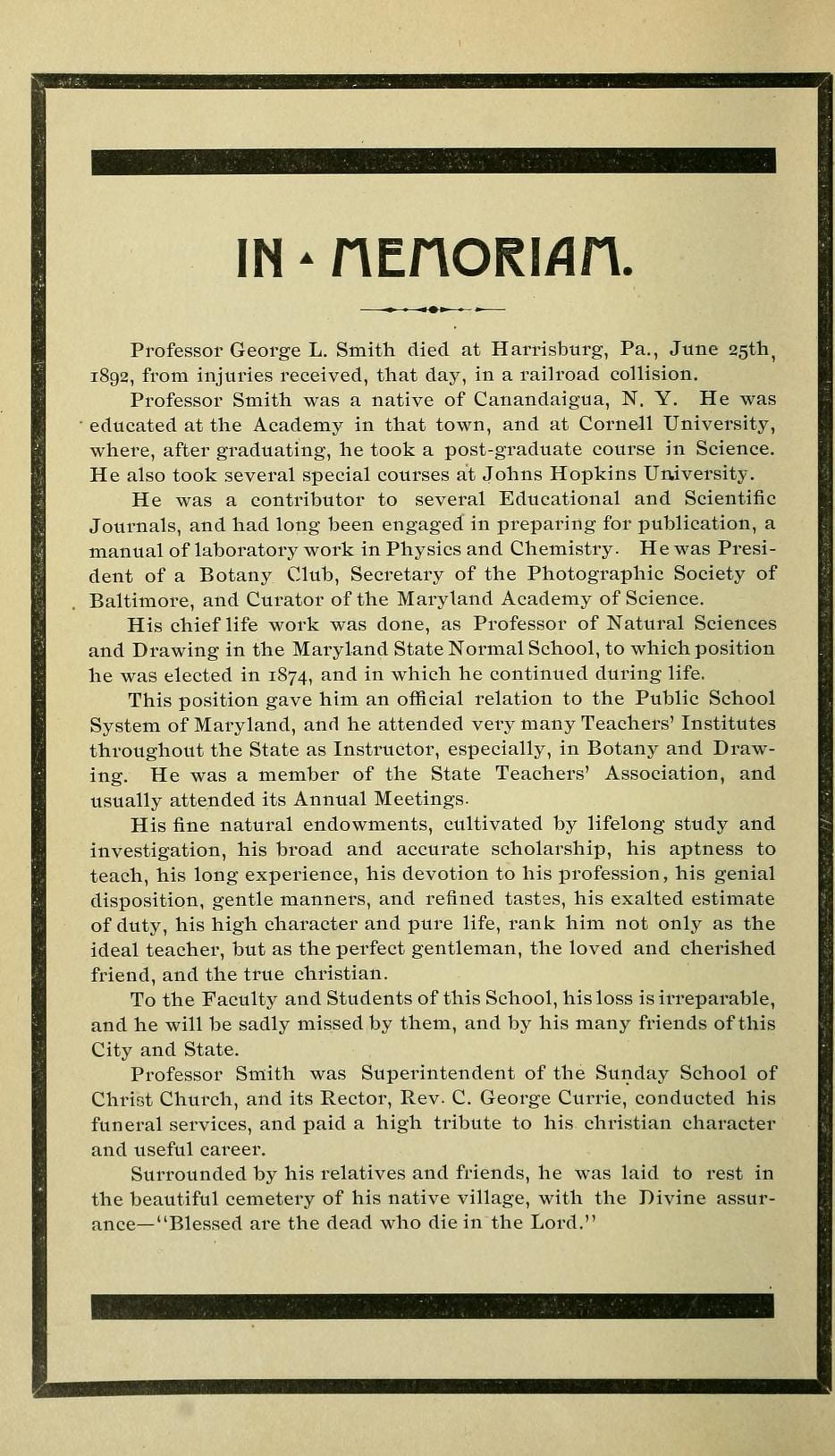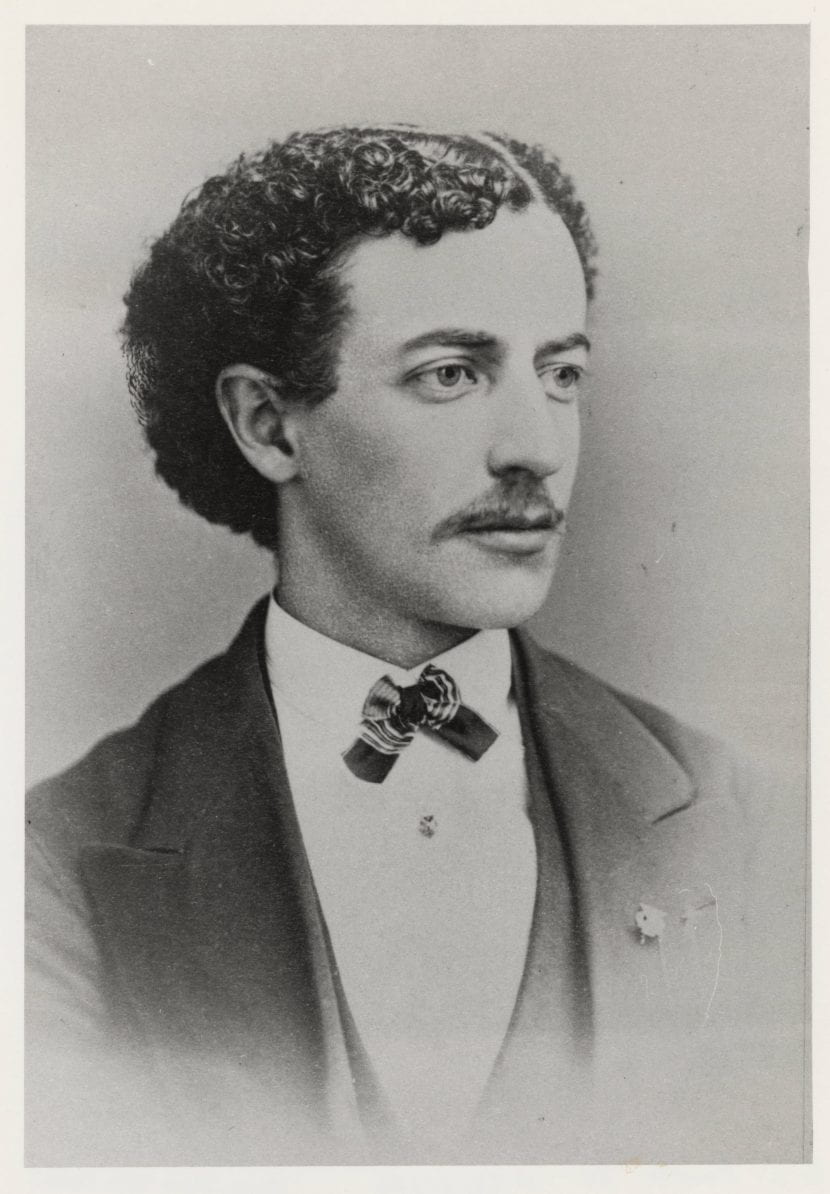To teach is to learn twice. – Joseph Joubert
The dashing gentleman in this undated photograph is George LaTour Smith. Born in 1847 in Canandaigua, New York, Smith joined the faculty at the Maryland State Normal School in 1875, a year after his own graduation from Cornell University.
MSNS was barely 10 years old and was just about to move to its first permanent home at the building on Carrollton and Lafayette Avenues. Smith was hired as an assistant professor to teach physics, chemistry, and natural history, While there had been instruction in botany and a lecturer who taught natural history, Smith was the first faculty member who specialized in the sciences at MSNS.
The students loved him. As Minnie Lee Davis, Class of 1877 wrote in 75 Years of Teacher Education: “It is not possible that any teacher could ever be more beloved than was Professor George Smith. Not only was he a truly great instructor, but there was never anyone who found more real joy in teaching. He made his pupils feel that he was benefited, not they; that they conferred a favor upon him when they asked for help.”
Before coming to MSNS, Smith worked with the U.S. Coast Survey to construct light houses along the Atlantic coast. It was while doing this work that Smith contracted a fever, and so he came to Baltimore to recover.
|
|
Through a mutual friend he met Mary Borgman who was at that time the Principal of the Model School and had worked at MSNS since 1867. Borgman also ran a boarding house for MSNS students and held salons on Friday evenings. Smith became a regular guest at these receptions and he and Borgman shared an enthusiastic interest in botany.
It was at Borgman’s urging that Smith applied for the position at MSNS, even though the salary offered was lower than the salary he was receiving from the U.S. Coast Survey. But perhaps he was already thinking of staying in Baltimore as he had met his future wife, Lily Armstrong, through Borgman.
|
|
| . |
When Smith joined the MSNS faculty, his first classes were not easy. As Sarah Richmond remembered in 1893, “His pupils were the graduating class, students of mature minds and some of them possessing considerable experience as teachers. Hitherto their instruction in these studies had been given by the Principal only, a man specially gifted as a teacher. The class rather resented the change and I suspect there was an inward feeling of satisfaction when an experiment of the new teacher’s failed in the promised effect.”
Smith, however, persevered. He recognized that he needed to gain more experience and so spent his nights in the laboratory at MSNS, studying just as much as the students he taught during the day.
|
|
Eventually Smith became full Professor, but his work extended beyond the sciences. For a bit, he took over the duties of Drawing instructor. He trained male students in Military Tactics as well as manual training such as carpentry. He was instrumental in the school’s Arbor Day festivities. Outside of his duties at MSNS, he was named Superintendent of the Samuel Ready School, a school for orphaned Maryland girls. He was a member of the Botany Club of Baltimore and Secretary for the Photographic Society of Baltimore. And he became a member and curator for the Maryland Academy of Sciences, the precursor to the Maryland Science Center.One of the most treasured items we have in the Archives is a book of photographs taken by Smith. He created this photo album as a Christmas gift for M.A. Newell in 1887. Through it, we can catch a glimpse of daily life at MSNS. There are photos of all the faculty, photos of all the classes arranged outside and individual students are identified, like J. Charles Linthicum, and even interior shots of the classrooms, including the Chemistry lab. This album has proven invaluable to us.
|
|
|
|
And it is made even more poignant by what happened to George LaTour Smith. As reported in the June 27, 1892 Baltimore

Sun: “Twelve lives were lost by the wreck of the Western Express on the Pennsylvania Railroad early yesterday morning. Prof. George L. Smith, of the Maryland State Normal School, Baltimore, was so badly injured that he died Saturday afternoon. His left leg was cut off at the thigh and he sustained a fracture of the left shoulder joint . . . . When the Normal School closed this year’s session, Prof. Smith took his wife and daughter to Canandaigua to spend the summer months, and went to Easton, Md. to take part in the opening of the summer school there. At the time of the accident, he was on his way to rejoin his family.”A telegraph operator on duty had been distracted by friends and had “allowed the second section of the train to go into the block before he learned definitely that the first section was still in the block”, essentially ramming heavy sleeping and baggage cars into three day coaches. The telegraph operator was immediately jailed for manslaughter while other engineers were also jailed for negligence.
The school went into deep mourning. Smith’s body was taken by his family and buried in Canandaigua. Letters and remembrances poured into the school, and a memorial was printed in the 1893 school catalog.
 |
| Smith’s portrait. |
In March of 1893, a memorial meeting was held by the MSNS Alumni Association and at that time, a painting of Smith commissioned from Baltimore portrait painter Paul Halwig was presented to the school. He is the only former faculty member to have been so honored.
Twenty-five years later, a scholarship was established in Smith’s name by the Alumni Association in the hopes of attracting highly qualified students who wanted to be teachers but lacked the funds to do so.
And Smith continues to hold sway in Towson University’s collective memory as the first science building constructed on campus in 1965 was named in his honor.
Almost 125 years after his death, we are still grateful to George LaTour Smith for the contributions he made to the school that would become Towson University.





